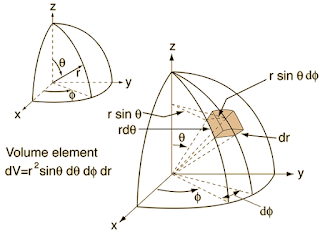A Quick Look at Spherical Coordinates
Because astronomy works on the Celestial Sphere, spherical coordinates play a very important role in astronomy. Most of the time we can ignore the intricacies of physics in 3-dimensions and work in a 2D far-field regime. (The far-field regime is just fancy speak for "small-angles"). However, it can be useful to understand why spherical coordinates are they way they are. Here, we will quickly derive the spherical differential volume element. Differential, just means vanishingly small. To let the cat out of the bag, the spherical differential volume element is,
\[ dV = r^2 \sin{\theta}\, dr\, d\theta \, d\phi .\]
The figure above shows the coordinate system we will be working with. This form is commonly used in astronomy, and also in some physics. However, it is different from the way mathematicians define it. In mathematics the \(\theta\) and the \(\phi\) are often switched. The astronomy convention is the more commonly used one in physics and astronomy (sorry mathematical physicists). Moving on.
Initially, we would be inclined to say that a differential box with sides of \((dr,\, d\theta,\, d\phi)\) would have a volume \(dV = dr\, d\theta \, d\phi\). Immediately we should realize this is wrong because the units are incorrect. The units of volume are \(L^3\) not \(L\times (angle)^2\). The being spherical, we must use the arc lengths of the sides, not just the angular lengths. For an arc, the arc length is \(s = r\theta\), where \(\theta\) is the angle subtended by an arc on a circle of radius \(r\). So what circles are our angle on?
The \(\theta\) coordinate measures the angle along great circles (the intersection of the surface of a sphere and a plane that passes through the center, i.e. circles that pass through the poles, like meridians). In other words, \(\theta\) measures the polar or zenith angle. The \(\phi\) coordinate measures angle along a circle placed at \(\theta\) from the zenith. The circle is the intersection of a cone with opening angle \(\theta\), starting at the origin, intersecting the sphere. Note that the radius of this circle will not necessarily be the radius of the sphere.
Now that we have defined which circles are relevant to which angles, we can determine the arc length. For \(d\theta\), the radius of the circle it lies on is always \(r\) because it is a great circle. For $d\phi$ the circle radius will depend on \(\theta\), specifically, if we examine the diagram, \(r \sin{\theta}\), because it is the distance to the z-axis, not the origin, that matters. This makes sense particularly if we notice how the lines of constant \(d\phi\) get closer as \(\theta \rightarrow 0\). Therefore, the area of that patch is
\[dA = r\, d\theta \times r\, d\phi,\]
and the volume is just \(dr \, dA\).



Comments
Post a Comment